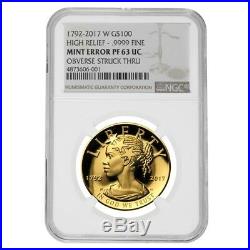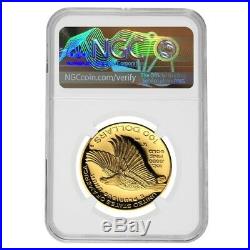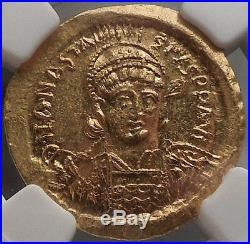
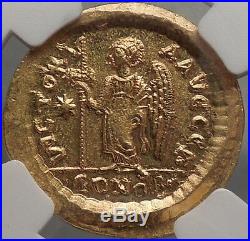
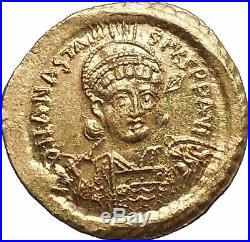
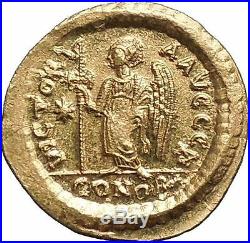
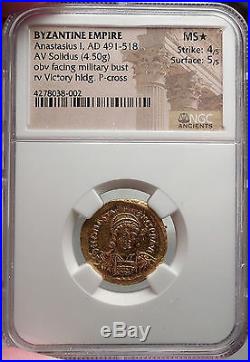
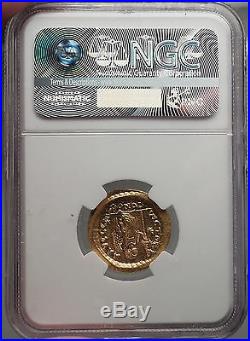
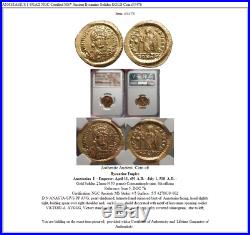

Authentic Ancient Coin of. Byzantine Empire Anastasius I – Emperor: April 11, 491 A. July 1, 518 A. Gold Solidus 21mm (4.50 grams) Constantinople mint, 8th officina Reference: Sear 5; DOC 7h Certification: NGC Ancients MS Strike: 4/5 Surface: 5/5 4278038-002 D N ANASTA-SIVS PP AVG, pearl-diademed, helmeted and cuirassed bust of Anastasius facing, head slightly right, holding spear over right shoulder and, on left arm, shield decorated with motif of horseman spearing soldier. VICTORI-A AVGGG, Victory standing left, holding long staff topped by reverted staurogram; star to left; H//CONOB. Flavius Anastasius Dicorus Augustus. 431 9 July 518 was Byzantine Emperor from 491 to 518. During his reign the Roman eastern frontier underwent extensive re-fortification, including the construction of Dara , a stronghold intended to counter the Persian fortress of Nisibis. During his reign was built one of the most fortified castle cities on the Adriatic Durrës Castle in Durrës. Background and personal characteristics. Anastasius was born at Dyrrhachium in the Latin-speaking part of the Balkans; the date is unknown, but he is thought to have been born no later than 430 or 431. He was born into an Illyrian family, the son of Pompeius born c. 410, nobleman of Dyrrachium, and wife Anastasia Constantina born c. His mother was an Arian , sister of Clearchus, also an Arian, and a paternal granddaughter of Gallus born c. 370, son of Anastasia born c. 352 and husband, in turn daughter of Flavius Claudius Constantius Gallus and wife and cousin Constantina. Anastasius had one eye black and one eye blue (heterochromia), and for that reason he was nicknamed Dicorus (Greek: , “two- pupiled “). At the time of the death of Zeno (491), Anastasius, a palace official (silentiarius), held a very high character, and was raised to the throne of the Eastern Roman Empire by Ariadne , Zeno’s widow, who preferred him to Zeno’s brother, Longinus. Ariadne married him shortly after his accession on 20 May 491. His reign, though afterwards disturbed by foreign and internecine wars and religious distractions, commenced auspiciously. He gained the popular favour by a judicious remission of taxation, and displayed great vigour and energy in administering the affairs of the Empire. Foreign policy and wars. Anastasius engaged in the Isaurian War against the usurper Longinus and the Anastasian War against Sassanid Persia. The Isaurian War (492-497) was stirred up by the Isaurian supporters of Longinus, the brother of Zeno who was passed over in his succession in favor of Anastasius. The battle of Cotyaeum in 492 “broke the back” of the revolt, but guerrilla warfare continued in the Isaurian mountains for some years longer. In the Anastasian War (502505), Theodosiopolis and Amida were captured by the Sassanids, but Persian provinces also suffered severely and the Byzantines recovered Amida. Both adversaries were exhausted when peace was made in 506 on the basis of the status quo. Anastasius afterwards built the strong fortress of Daras to hold the Persians in check in Nisibis. The Balkan provinces were left denuded of troops, however, and were devastated by invasions of Slavs and Bulgars ; to protect Constantinople and its vicinity against them, the emperor built the Anastasian Wall , extending from the Propontis to the Euxine. Domestic and ecclesiastical policies. The Emperor was a convinced Miaphysite , following the teachings of Cyril of Alexandria and Severus of Antioch who taught “One Incarnate Nature of Christ” in an undivided union of the Divine and human natures, but his ecclesiastical policy was moderate; he endeavoured to maintain the principle of the Henotikon of Zeno and the peace of the church. It was rebellious demonstrations of the Byzantine populace, that drove him in 512 to abandon this policy and adopt Miaphysitic programme. His consequent unpopularity in the European provinces was utilized by an ambitious man, named Vitalian , to organize a dangerous rebellion, in which he was assisted by a horde of ” Huns ” (514515); it was finally suppressed by a naval victory won by the general Marinus. The Anonymous Valesianus tells an account about his choosing of a successor: Anastasius could not decide which of his three nephews should succeed him, so he put a message under a couch and had his nephews take seats in the room, which also had two other seats; he believed that the nephew to sit on the special couch would be his proper heir. However, two of his nephews sat on the same couch, and the one with the concealed message remained empty. Then, after putting the matter to God in prayer , he determined that the first person to enter his room the next morning should be the next Emperor, and that person was Justin , the chief of his guards. In fact, Anastasius probably never thought of Justin as a successor, but the issue was decided for him after his death. At the end of his reign, he left the Imperial treasury richer by 23,000,000 solidi or 320,000 pounds of gold. Anastasius died childless in Constantinople on 9 July 518 (some sources say 8 or 10 July) and was buried at the Church of the Holy Apostles. Anastasius is known to have had a brother named Flavius Paulus , who served as Roman consul in 496. A sister-in-law, known as Magna, was mother to Irene and mother-in-law to Olybrius. This Olybrius was son of Anicia Juliana and Areobindus Dagalaiphus Areobindus. The daughter of Olybrius and Irene was named Proba. She married Probus and was mother to a younger Juliana. This younger Juliana married another Anastasius and was mother of Areobindus, Placidia, and a younger Proba. Another nephew of Anastasius was Flavius Probus , Roman consul in 502. Caesaria, sister of Anastasius, married Secundinus. They were parents to Hypatius and Pompeius. Flavius Anastasius Paulus Probus Moschianus Probus Magnus , Roman Consul in 518 also was a great-nephew of Anastasius. His daughter Juliana later married Marcellus , a brother of Justin II. The extensive family may well have included viable candidates for the throne. Byzantine Empire coinage reform. The main elements of the complex monetary system of the early Byzantine Empire, which suffered a partial collapse in the 5th century, were revived by Emperor Anastasius I (491518) in 498. The new system involved three denominations of gold (the solidus and its half and third) and five of copper (the follis, worth 40 nummi and its fractions down to a nummus). A 40 nummi coin of Anastasius is depicted on the obverse of the Macedonian 50 denars banknote, issued in 1996. Died: 9 July 518. Consul of the Roman Empire 492 with Flavius Rufus. Flavius Albinus Iunior , Flavius Eusebius II. Paulus , Post consulatum Viatoris (West). Consul of the Roman Empire 497. Paulinus , John the Scythian. Flavius Ennodius Messala , Areobindus Dagalaiphus Areobindus. Consul of the Roman Empire 507 with Venantius iunior Clovis I. The Byzantine Empire , or Eastern Roman Empire , was the predominantly Greek -speaking eastern half continuation and remainder of the Roman Empire during Late Antiquity and the Middle Ages. Its capital city was Constantinople (modern-day Istanbul), originally founded as Byzantium. It survived the fragmentation and fall of the Western Roman Empire in the 5th century AD and continued to exist for an additional thousand years until it fell to the Ottoman Turks in 1453. During most of its existence, the empire was the most powerful economic, cultural, and military force in Europe. Both “Byzantine Empire” and “Eastern Roman Empire” are historiographical terms created after the end of the realm; its citizens continued to refer to their empire as the Roman Empire Ancient Greek. , and to themselves as “Romans”. Several events from the 4th to 6th centuries mark the transitional period during which the Roman Empire’s east and west divided. In 285, the emperor Diocletian r. 284305 partitioned the Roman Empire’s administration into eastern and western halves. Between 324 and 330, Constantine I r. 306337 transferred the main capital from Rome to Byzantium , later known as Constantinople (“City of Constantine”) and Nova Roma (“New Rome”). Under Theodosius I r. 379395, Christianity became the Empire’s official state religion and others such as Roman polytheism were proscribed. And finally, under the reign of Heraclius r. 610641, the Empire’s military and administration were restructured and adopted Greek for official use instead of Latin. Thus, although it continued the Roman state and maintained Roman state traditions, modern historians distinguish Byzantium from ancient Rome insofar as it was oriented towards Greek rather than Latin culture, and characterised by Orthodox Christianity rather than Roman polytheism. The borders of the Empire evolved significantly over its existence, as it went through several cycles of decline and recovery. During the reign of Justinian I r. 527565, the Empire reached its greatest extent after reconquering much of the historically Roman western Mediterranean coast, including north Africa, Italy, and Rome itself, which it held for two more centuries. During the reign of Maurice r. 582602, the Empire’s eastern frontier was expanded and the north stabilised. However, his assassination caused a two-decade-long war with Sassanid Persia which exhausted the Empire’s resources and contributed to major territorial losses during the Muslim conquests of the 7th century. In a matter of years the Empire lost its richest provinces, Egypt and Syria, to the Arabs. During the Macedonian dynasty (10th11th centuries), the Empire again expanded and experienced a two-century long renaissance , which came to an end with the loss of much of Asia Minor to the Seljuk Turks after the Battle of Manzikert in 1071. This battle opened the way for the Turks to settle in Anatolia as a homeland. The final centuries of the Empire exhibited a general trend of decline. It struggled to recover during the 12th century , but was delivered a mortal blow during the Fourth Crusade , when Constantinople was sacked and the Empire dissolved and divided into competing Byzantine Greek and Latin realms. Despite the eventual recovery of Constantinople and re-establishment of the Empire in 1261 , Byzantium remained only one of several small rival states in the area for the final two centuries of its existence. Its remaining territories were progressively annexed by the Ottomans over the 15th century. The Fall of Constantinople to the Ottoman Empire in 1453 finally ended the Byzantine Empire. What is a certificate of authenticity and what guarantees do you give that the item is authentic? You will be quite happy with what you get with the COA; a professional presentation of the coin, with all of the relevant information and a picture of the coin you saw in the listing. Is there a number I can call you with questions about my order? When should I leave feedback? Once you receive your order, please leave a positive. Please don’t leave any negative feedbacks, as it happens many times that people rush to leave feedback before letting sufficient time for the order to arrive. The matter of fact is that any issues can be resolved, as reputation is most important to me. My goal is to provide superior products and quality of service. The item “ANASTASIUS I 491AD NGC Certified MS Ancient Byzantine Solidus GOLD Coin i53476″ is in sale since Friday, May 27, 2016. This item is in the category “Coins & Paper Money\Coins\ Ancient\Byzantine (300-1400 AD)”. The seller is “highrating_lowprice” and is located in Rego Park, New York. This item can be shipped worldwide.
- Certification: NGC
- Certification Number: 4278038-002
- Grade: MS*
- Material: Gold


